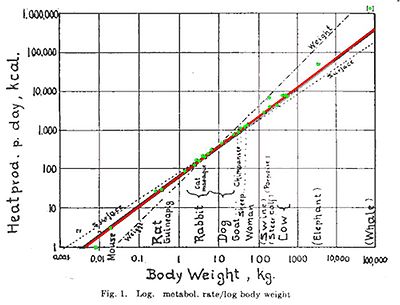Michael Alexander sent along this excerpt from Steven Johnson’s book, “Where Good Ideas Come From.”
Scientists and animal lovers had long observed that as life gets bigger, it slows down. Flies live for hours or days; elephants live for half-centuries. The hearts of birds and small mammals pump blood much faster than those of giraffes and blue whales.
But the relationship between size and speed didn’t seem to be a linear one. A horse might be five hundred times heavier than a rabbit, yet its pulse certainly wasn’t five hundred times slower than the rabbit’s. After a formidable series of measurements in his Davis lab, [Swiss scientist Max] Kleiber
discovered that this scaling phenomenon stuck to an unvarying mathematical script called ‘negative quarter-power scaling.’
If you plotted mass versus metabolism on a logarithmic grid, the result was a perfectly straight line that led from rats and pigeons all the way up to bulls and hippopotami. … The more species Kleiber and his peers analyzed, the clearer the equation became: metabolism scales to mass to the negative quarter power….
Several years ago, the theoretical physicist Geoffrey West decided to investigate whether Kleiber’s law applied to one of life’s largest creations: the superorganisms of human-built cities. Did the ‘metabolism’ of urban life slow down as cities grew in size? Was there an underlying pattern to the growth and pace of life of metropolitan systems?
Working out of the legendary Santa Fe Institute, where he served as president until 2009, West assembled an international team of researchers and advisers to collect data on dozens of cities around the world, measuring everything from crime to household electrical consumption, from new patents to gasoline sales.
When they finally crunched the numbers, West and his team were delighted to discover that Kleiber’s negative quarter-power scaling governed the energy and transportation growth of city living. The number of gasoline stations, gasoline sales, road surface area, the length of electrical cables: all these factors follow the exact same power law that governs the speed with which energy is expended in biological organisms. If an elephant was just a scaled-up mouse, then, from an energy perspective, a city was just a scaled-up elephant.
But the most fascinating discovery in West’s research came from the data that didn’t turn out to obey Kleiber’s law. West and his team discovered another power law lurking in their immense database of urban statistics. Every datapoint that involved creativity and innovation – patents, R&D budgets, ‘supercreative’ professions, inventors – also followed a quarter-power law, in a way that was every bit as predictable as Kleiber’s law.
But there was one fundamental difference: the quarter-power law governing innovation was positive, not negative. A city that was ten times larger than its neighbor wasn’t ten times more innovative; it was seventeen times more innovative. A metropolis fifty times bigger than a town was 130 times more innovative.
Kleiber’s law proved that as life gets bigger, it slows down. But West’s model demonstrated one crucial way in which human-built cities broke from the patterns of biological life: as cities get bigger, they generate ideas at a faster clip. This is what we call ‘superlinear scaling’: if creativity scaled with size in a straight, linear fashion, you would of course find more patents and inventions in a larger city, but the number of patents and inventions per capita would be stable.
West’s power laws suggested something far more provocative: that despite all the noise and crowding and distraction, the average resident of a metropolis with a population of five million people was almost three times more creative than the average resident of a town of a hundred thousand.













The implications of Kleiber’s Law extend to many social movements — especially when it is combined with laws governing social networks and innovation.
Hello,
Can you recommend books and papers in this area ie Kleiber-nomics…
Thanks.
Richard
Cambridge Forecast Group
I was describing Kleiber’s theory to a colleague who pointed out that parrots have a fast heartbeat yet can live to be 100. How many organisms fall away from Kleiber’s line ?
A good read:
http://www.nytimes.com/2010/12/19/magazine/19Urban_West-t.html
“West considers urban theory to be a field without principles”…………….which is why I have in the past published the following ethical code based on the Hippocratic Oath sworn by physicians. It is applicable to urban designers, city planners, transportation planners, architects, landscape architects, and civil engineers, in other words it is applicable to all of the consulting professions that enable the development of the city; the ones responsible for the quality of life found in the city and the condition of the biosphere generally.
An Urbanists Oath
I will take care that my clients, the public and nature suffer no hurt or damage.
I will comport myself in an upstanding manner and use my knowledge for good.
I will not be ashamed to say, “I know not.”
I will willingly refrain from doing any injury or wrong from falsehood.
I will remember that I remain a member of society, with special obligations to all my fellow human beings.
I will remember that I am part of the web of life on planet Earth.